Should you carry a firearm with one in the chamber? I run into this question now and then, most recently during a medical appointment. As usual, the question involved semiautomatic pistols, and was slanted toward concealed carry.
Anyone carrying a handgun for defensive purposes should carry with a loaded chamber so long as they have sufficient training.
Although perhaps a surprise to some, those who “carry” firearms for defensive purposes constitute a diverse spectrum of our society.
Exactly who they are remains a mystery because their firearms are concealed. The vast majority are responsible citizens well-versed in the moral and legal aspects of carrying a firearm. They fully understand the firearm is the last resort. Unfortunately, if ever needed, there won’t be time for delays.
Handguns aren’t the only concern. Shotguns and rifles and rifles are also employed for defense purposes, although the majority probably see more sporting use. If the latter is the case, stone walls and tree stands can introduce real safety concerns. I dealt with similar issues on a fairly large scale while fielding firearms for a state agency.
With steep stairways, elevated platforms, and vehicles in the mix, things could get “interesting” in a hurry. Holsters provide two free hands and slings may accomplish this to some extent, but bumps and knocks are inevitable.
Since handguns are probably the most relevant subject for many, we might as well start there.
Handguns
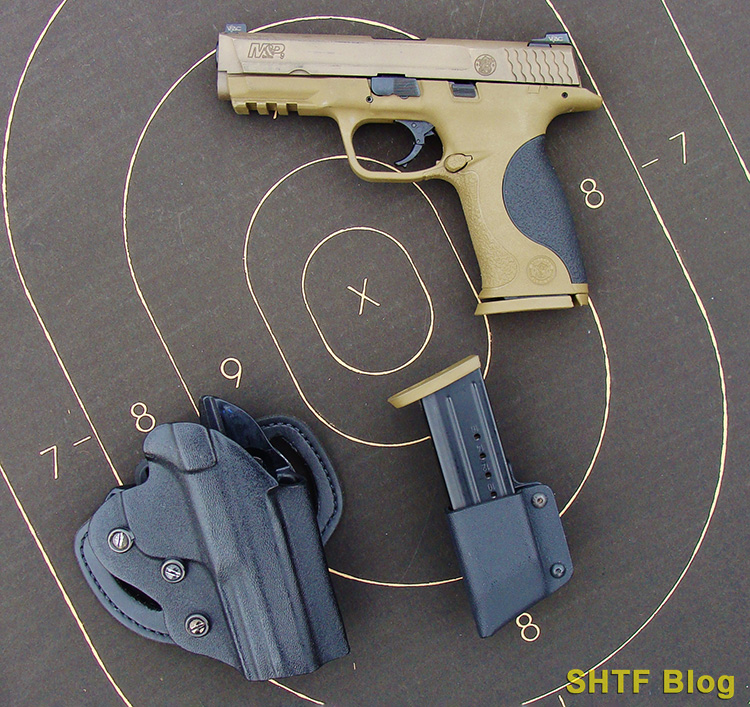
Everyone I know who carries a handgun professionally has a chambered round. Of course, a revolver would be useless otherwise. Some small D/A types are still carried as backup guns, but nowadays, most people who wear badges carry some type of semiautomatic pistol.
The combination of in-depth training and regular carry go a long way to maintaining proficiency – a good thing during stressful situations! If the handgun is needed, the response will likely be reactive, with no real time to think things over. Those I know who survived armed encounters never started their days by planning on one.
The theme was pretty much the same across the board; whatever happened just erupted out of the blue. Civilians will be in the same boat. The chosen system had better be a familiar one, carried in a consistent manner. I’m a holster guy but some people use other methods, some of which involve creative alternatives.
Empty Chambers and One Fellow
At one point I was a source of certification for issuance of concealed-carry permits. Among those who attended these programs, one especially memorable “student” was an Israeli Surgeon with a well-maintained but vintage .380 Browning Model 1910. This pistol was an early striker-fired design with a small safety lever and additional grip safety.
The “holster” was a fanny-pack, secured on his left hip. The pistol was carried inside the pack, off “safe,” with an empty chamber. The doctor had an aura of confidence, so this being a private lesson, I finally conceded to a demonstration.
Big surprise for yours truly! As a righty, he executed a flawless cross-draw while unzippering the pouch with his support hand. Next came a fast slide-rack, a two-handed grip, and pair of instantaneous shots.
The whole thing happened so fast it made my head spin. Several additional presentations were equally impressive – as was the ensuing shot group. More amazingly, the good doctor was point-shooting which, given the pistol’s miniscule sights and dim indoor lighting conditions, might’ve been his only viable choice. The safety lever was also tiny and easy to miss. As it turned out though, none of this really mattered.
The technique had been mastered while training with an elite Israeli security force. Still, there was one potentially fatal flaw; it required two hands…
A resident of our state learned of this shortcoming the hard way during an encounter with a machete-wielding home invader. During the attack that followed, the first swipe nearly severed the homeowner’s left wrist. He managed to grab a pistol with his right hand during the melee – but its chamber was empty.
Rendered defenseless, both he and a daughter suffered grievous wounds, severe enough that they were left for dead. Although both eventually recovered to some extent, their lives will never be the same.
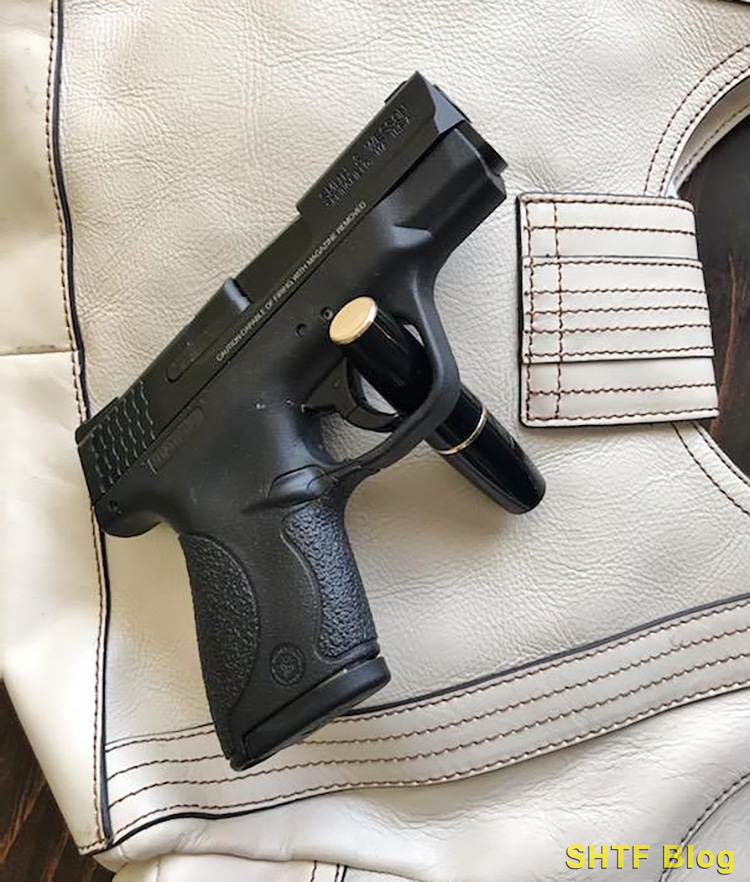
Carrying Concealed
Some people use purses or briefcases, etc., but I’m only comfortable when the gun is safely secured in on my person. For me, this means a suitable holster, solidly attached to a belt. The entire system, including spare magazines, will also be out of sight. And, of course, the pistol will have a chambered round.
This is less of a concern with the “right” gun. By that, I mean one that you are comfortable with! Whatever the final choice, it should be a suitable choice for the carry method. An active safety is worthwhile if the gun travels in a purse, etc. Proper training is also essential. In the long run it can even save money that would otherwise be squandered on useless items.
See my article on concealed carry tips for more information on this subject. Brownell’s, for their part, has a mixed view on the subject.
Home Defense
If something goes bump in the night, good luck loading a revolver in the dark. The better bet is a secure but foolproof rapid-access container. An example is available from Amazon below (also available at Optics Planet).
- Discreet, Secure, Touch-Free Entry - the Hornady Rapid Safe Night Guard, 98215 keeps your handgun safes for pistols as close as your nightstand. It's hidden in plain sight, plus the additional functionality of a clock and USB charging points, use it as your bedroom gun safe, living room safe, or closet safe
- Quick Access Gun Safe - This Hornady gun safe uses the patented RFID technology to unlocks safes faster than keypads and biometric gun safe for handgun. Four included RFID tags can be selectively programmed to open this safe and any other RFID gun safe you own.
- Heavy Duty and Tamper Proof – This nightstand safe is made from 14 gauge steel. Comes with a heavy duty 1500 lb. steel lock-down security cable that attaches the portable safe to any stationary object and features 2 internal hardened locking lugs. Easy to install
- Sizing and Specifications – Item 98215. Exterior: 3" x 12" x 10.5", Interior: 2.2" x 9.2" x 6.9". Accommodates most full-sized handguns and/or valuables. Includes Rapid Safe Night Guard clock Safe, wristband, key fob, (2) decals, (2) circular barrel keys, 1500 lb. security cable and AC power cord. 2 USB-A ports for charging devices
- Tempered Glass Front Panel – This bedside gun safe elegantly displays the RDID reader, clock, and the access code keypad. The spring-assist drawer box quietly slides open to reveal a padded interior to store your pistols. AC and battery power ensures your guns and valuables are protected and ready, 24/7
Using this method, you could go the empty-chamber route, assuming the pistol is reserved for this role. But, you’d better have the drill down pat – and two working hands. Here is some more advice on home defense against invasions.
Single-action revolver footnote: Some designs (like Colt’s Model 1873 Six-Shooter) should be carried with an empty chamber underneath the hammer. Otherwise, a hard blow could cause a discharge!
Shotguns
Because of safety concerns, most law enforcement agencies have established carry protocols. They vary and some are described using different terms, such as “cruiser carry.”
I’ll use our agency’s Remington Model 870 Police 12 gauge pump-guns to illustrate a load-mode that has served us well for decades. It could apply to many other repeating shotguns as well.
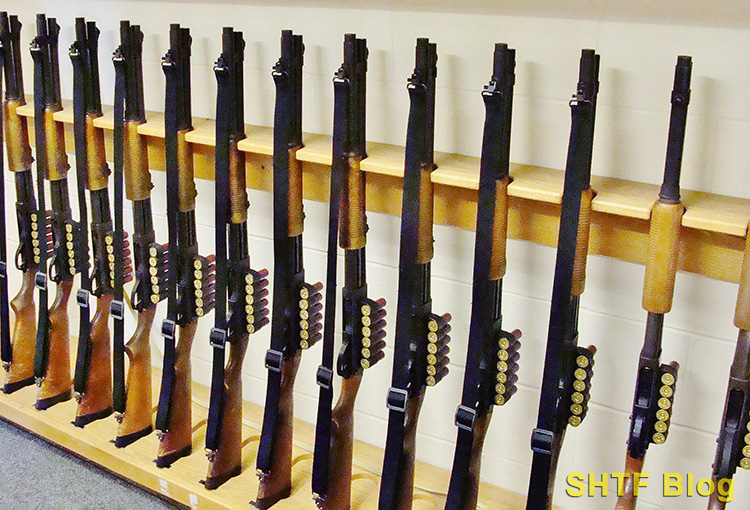
Defense
First, some rationale. For starters, a long gun won’t be in a holster. Also, most shotguns fire from pre-cocked hammers. With many designs (like an 870), the safety only blocks the trigger, meaning a hard knock or dropped gun could cause a discharge – if the chamber contains a shell.
LE Examples
Our agency’s shotgun standard operating procedure (SOP) specifies an empty chamber for shotguns. The magazine tube is full (7 shells), and the gun is carried with its safety “on.” Unlike some other agencies, our guns are also cocked. In that condition the slide is locked forward.
Chambering a shell requires activation of the slide-stop lever, followed by an attention-getting slide-rack. At that point, if time permits, the magazine can be topped off. Result: A formidable 8+1 defensive weapon!
Other agencies modify this condition by dropping the hammer on an empty chamber, sometimes while leaving the safety “off.” The slide will then be unlocked to permit instant chambering of a shell – whether on purpose, or not. One of our local finest is missing a body part because of this practice.
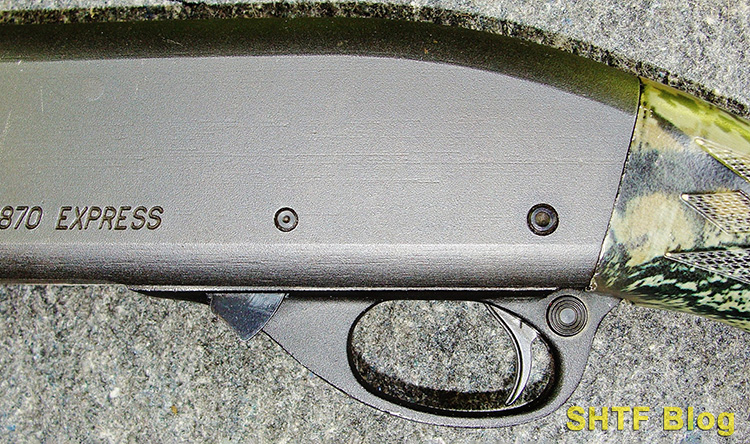
Instead, we invest heavily in training. It’s easy enough to contact the slide release with the trigger finger, and a whole lot more subtle than establishing a grip on a handgun. The safety can be disengaged during the gun mount, so the shot can be just as fast. Tying in with this, much training centers on the approved carry condition, including clearance of the chamber. Because much use involves vehicles, locked racks are a further precaution (ours orient the muzzles upright).
But, again, SOPs can vary. Two close family members on the Left Coast patrol some pretty lively jurisdictions. They too employ M-870s in locking racks with one big difference – their chambers contain live shells. Most of us will be a whole lot safer with another plan.
The Civilian Side
As far as shotguns go, a loaded chamber in a vehicle is a recipe for disaster, and it’s also illegal in many locales. In any case, the above carry-condition is a much safer alternative. It could also the ticket for home defense when combined with a rapid-access gun vault.
Some of latest Three Gun autoloaders feature large controls and accessory mounts, making them ideal candidates for such an approach.
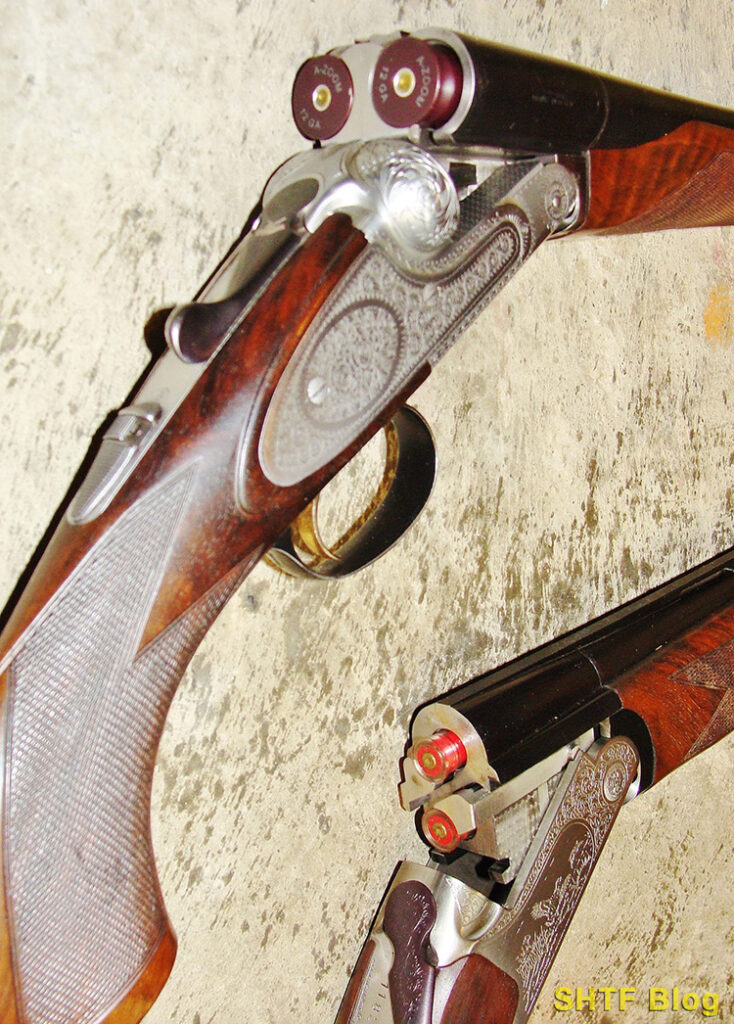
A pair of double-guns with their barrels popped open. The “shells” are actually snap-caps. 
Stone walls and loaded shotguns don’t mix well for people or dogs. Easy fix though: Exercise common sense – and enjoy the splendors of autumn.
Sporting Shotguns
Everyone in my area hunts with a chambered shell (or two). Pumps and autoloaders are more common but double guns are more forgiving for navigation of obstacles. Our woods and fields are full of old stone walls.
It’s tempting to make a leap with a loaded chamber, but an empty one is a whole lot safer. At a minimum, you can at least open the barrels of a double-gun during an easy crossing.
Actually, with the right technique, many pumps can be cleared without feeding another shell. Some autoloaders are also handy in this regard; one reason I often hunt with Berettas. Before sending my trusty Labrador for a boat retrieve, I’ll first draw back the bolt to extract the chambered shell.
The gun won’t feed another one until I trip the gun’s carrier-latch. And, that won’t occur until my 80-pound waterfowl retriever is safely back aboard. For extra safety, the boat is equipped with gun racks. A gun won’t go in the rack with a loaded chamber – similar to LE practices.
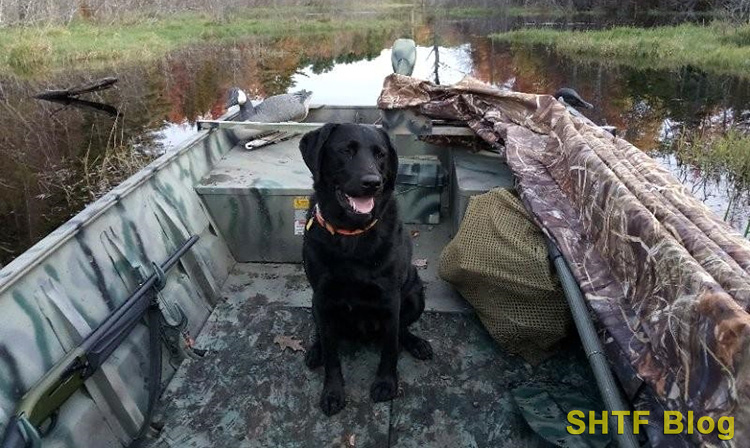
Safety
Spend some time getting familiar with your shotgun and you may pick up on a few function tricks. Some people cycle every shell through the chamber of a repeater to unload the gun, even though it may not be necessary.
For example, once I clear the chamber of a Beretta (per above), the shells in the magazine can be removed by pressing inward on the bolt release. Fully understand the function of the gun and safety will greatly improve.
Rifles
The above shotgun concerns pretty much apply to rifles. Again, regarding defense, I’ll use our agency’s rifles as an example.
Defense
The ubiquitous AR-15 has largely supplanted the shotgun for routine LE patrol use, but carry conditions really boil down to just two: a round in the chamber – or not. For routine use, we opt for the latter.
Like most shotguns, the AR fires from a cocked hammer. Those with mil-spec triggers are safer in this regard – but an empty chamber is safer yet; and many civilian AR-15s (including a few of mine) have lighter triggers.

LE Examples
Regardless, duty use can involve rough handling. Thus, our AR-15s are carried with an empty chamber, cocked hammer, safety “on,” and a full magazine. Others drop the hammer on an empty chamber so the safety can’t be reengaged, the theory being a fast bolt-rack will maximize defensive readiness. But, because our ARs receive regular chamber checks, we choose to play it safe (literally).
Civilian Side
The AR, in its various forms, is a popular choice for home defense. The condition described above may be practical for some residential settings (or even vehicles) with a caveat; a secure storage system!
One worthwhile addition for owners of 5.56 (or .223) ARs is Hornady’s Rapid-Rack device.
It serves as an unloaded chamber flag, and also doubles as a charging handle for fast chambering of a cartridge from the magazine. A similar strategy could be adopted for other types of firearms.
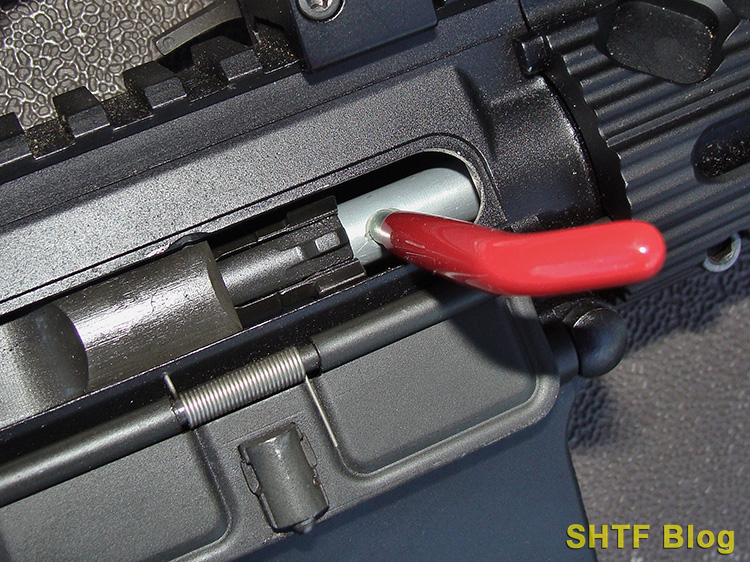
Sporting Rifles
In the thick woods of my state, just about everyone hunts game animals with a chambered round. This practice also causes grief when people take shortcuts involving tree stands, frozen beaver flowages, etc.
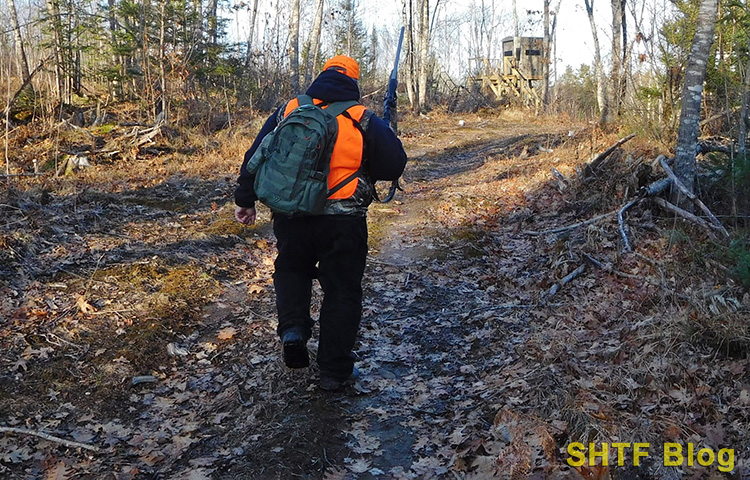
Last week I climbed into an elevated deer blind but, first, because it had a set of stairs with a railing, I ejected the chambered round.
The cartridge was then reinserted into the magazine of my rifle, and the bolt was run home on an empty chamber. One safely in the blind, it was easy enough to rechamber the cartridge.
This same strategy is often employed in the open expanses of western states where hunting involves spotting scopes and horses. It’s also a whole lot safer in difficult terrain.
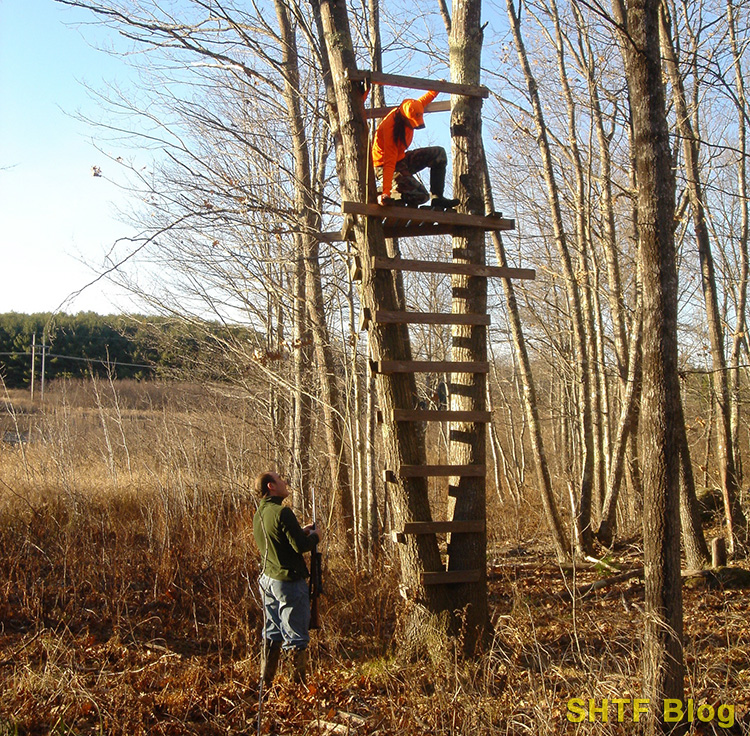
Safety
The key is attention to details biased toward worst-case scenarios. One of my son’s friends just returned from an Alaskan bear hunt. He shot a large brown bear which promptly disappeared in a brushy ravine. The guide went in after it and received a vicious mauling. Yup, you guessed it; he forgot to chamber a round.
Less intimidating threats include tree stands, but they’re still worthy of respect. Prior to climbing, completely unload the rifle and tether it to a hoist. Once properly situated in the stand, the firearm can be safely hauled up (factoring the direction of its muzzle). Descend using the same procedure reversed. And, again familiarity with the firearm goes a long way toward maximizing safety.
Final Comments On Readiness
In an earlier life in far-flung places, hairy situations were the norm. So were M-16s and other military ordnance, all of which had loaded chambers. Thankfully, those days are over.
Now, like LE personnel and responsible armed citizens, my primary concern is safety. But, of course, defensively, it’s all a balance. My handgun will still have a chambered round, but a rifle or shotgun won’t – at least not for home defense.
But, of course, one never knows when a situation could turn for the worse. An imminent threat calls for a maximized degree of readiness and that boils down to judgement.
Enter harm’s way with an empty chamber and the outcome could be unpleasant.


1 comment
I detest these bloody cowboy wanna-be’s who spend time and money enabling the pointless killing of animals in their own habitat minding their own business. It’d be a different story if the targets could shoot back. And PROTECTIVE shooting is easy: I’ve done so on a number of occasions. (with the eventual approval of the courts). Sneak up behind the ‘intruder’ and blow him away with a load of buckshot without warning. Then walk away